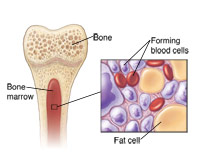Hemoglobin C Disease
Red blood cells transport oxygen throughout the body to cells, tissues, and organs use that oxygen to function properly. Red blood cells carry oxygen via hemoglobin, a protein contained within the cells.
 |
| Click to Enlarge |
Hemoglobin comes in many types; people inherit the type of hemoglobin they have from their parents. Most people carry hemoglobin A in their red blood cells. Those who carry hemoglobin C, considered an abnormal variation, may develop hemoglobin C disease. This blood disorder develops because the red blood cells do not contain enough water and are too rigid. They break down earlier than they should, leaving too few in the blood and leading to mild anemia.
Facts about hemoglobin C disease
If two parents pass on a hemoglobin C trait, their baby will carry hemoglobin C in his or her red blood cells. That does not mean the child will automatically have hemoglobin C disease. It is possible to carry the hemoglobin C trait without having the disease or any health problems. In fact, a baby born to parents who each carry the trait has a 25 percent chance of having hemoglobin C disease and developing symptoms.
In the U.S., hemoglobin C is most common in African-Americans. People of Caribbean, Italian, and Greek descent also have a higher risk of developing hemoglobin C disease.
Symptoms
Most people with the hemoglobin C disease don't have symptoms and can live normal lives, but they will have a low blood count or anemia.
If symptoms do develop, they may include:
-
Reduced red blood cell counts during infection or illness
-
Increased risk for gallstones
-
Enlarged spleen
-
Episodes of joint pain
-
Increased risk for infection
Diagnosis
A blood test can diagnose hemoglobin C disease. The disorder is often found during newborn screening tests that look for any abnormalities.
Treatment
Although hemoglobin C disease is a chronic condition, it usually doesn't require any treatment. The anemia that develops is mild and rarely interferes with everyday life. Neither children nor adults need any special therapy, vitamins, or iron supplements to treat hemoglobin C disease.
Prevention
Hemoglobin C disease is an inherited, congenital disease. There is no known way to prevent it. Blood tests of both parents before pregnancy can indicate their child's chances of having hemoglobin C disease.
Complications
Hemoglobin C disease usually requires no special medical attention, but sometimes complications can develop, including:
When to call the doctor
Children with hemoglobin C disease may develop complications as they grow up. If your child has frequent or persistent infections or has symptoms of gallstones (pain in the upper abdomen or back, especially after eating), talk with your child's doctor. An ultrasound can confirm gallstones. Preventive antibiotics may be prescribed to help reduce the risk for infections. Children with enlarged spleens should take care to avoid high-contact sports to reduce the risk for injury.
Key points to remember
Children and adults can live long and healthy lives with hemoglobin C disease because symptoms are uncommon or generally quite mild. Most people just need to be aware of the condition and alert for any possible complications.